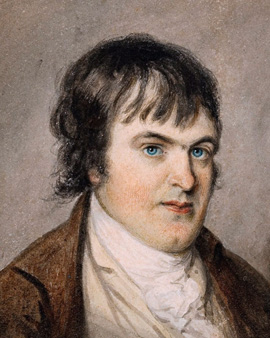John Glover was a British painter who became known in Australia as the "father of Australian landscape painting". Glover was born in the village of Houghton-on-Hill in the English county of Leicestershire. Already as a child he showed a talent for drawing. From 1794 he taught art in Lichfield.
In 1805 Glover moved to London and became a member of the "Old Water Colour Society", whose president he became just two years later. In the following years he exhibited a large number of paintings at events of the Society, but also at the Royal Academy and the Society of British Artists. In 1823 and 1824 he had individual exhibitions in London. He was a very successful artist, and although he was never a member of the Academy, he enjoyed the highest esteem among the population. Glover gained fame as a painter of "Italian" landscapes of England and Southern Europe. Following the French painter of the seventeenth century, Claude Lorrain, he was even called "the English Claude" on both sides of the Channel - Laurrain had an immense influence on the development of English landscape painting.
Glover decided to move to Australia. He arrived in Tasmania in 1831, on his 64th birthday. His reputation as a great landscape painter preceded him. Glover first lived in Hobart and then bought a large plot of land in Deddington. There he was the neighbour of John Batman, the later co-founder of Melbourne. Glover became well known for his portraits of Tasmanian landscapes. He developed a new style of painting for them, moving away from the worn colours that were common in English landscape painting and towards clear, bright colours with which he could capture the light of the Australian sun. His depiction of the Australian plant world was also new, as it was very accurate. However, he portrayed the Aborigines of the continent as free people in untouched nature, when in reality they had to suffer oppression, expropriation and violence by the colonial masters.
He painted his last larger picture on his 79th birthday. Three years later he died on his estate in Deddington, where he is buried in the chapel there.
×





 - (MeisterDrucke-272754).jpg)
 - (MeisterDrucke-272754).jpg)
.jpg)
.jpg)
.jpg)
.jpg)
.jpg)
.jpg)
.jpg)
.jpg)
.jpg)
.jpg)
 and pencil on paper) - (MeisterDrucke-190364).jpg)
 and pencil on paper) - (MeisterDrucke-190364).jpg)
.jpg)
.jpg)
.jpg)
.jpg)
.jpg)
.jpg)
_-_(MeisterDrucke-1111386).jpg)
_-_(MeisterDrucke-1111386).jpg)
.jpg)
.jpg)
.jpg)
.jpg)
_(The_bath_of_Diana_-_Van_Diemens_La_-_(MeisterDrucke-1314101).jpg)
_(The_bath_of_Diana_-_Van_Diemens_La_-_(MeisterDrucke-1314101).jpg)
 - (MeisterDrucke-224931).jpg)
 - (MeisterDrucke-224931).jpg)
.jpg)
.jpg)
.jpg)
.jpg)
.jpg)
.jpg)
.jpg)
.jpg)
 - (MeisterDrucke-266792).jpg)
 - (MeisterDrucke-266792).jpg)
_-_(MeisterDrucke-1511374).jpg)
_-_(MeisterDrucke-1511374).jpg)
.jpg)
.jpg)
.jpg)
.jpg)
_-_(MeisterDrucke-901476).jpg)
_-_(MeisterDrucke-901476).jpg)
.jpg)
.jpg)
.jpg)
.jpg)
.jpg)
.jpg)
.jpg)
.jpg)
 and pencil on pape - (MeisterDrucke-247391).jpg)
 and pencil on pape - (MeisterDrucke-247391).jpg)
.jpg)
.jpg)
.jpg)
.jpg)
_-_(MeisterDrucke-1132458).jpg)
_-_(MeisterDrucke-1132458).jpg)
.jpg)
.jpg)
.jpg)
.jpg)
_-_(MeisterDrucke-385054).jpg)
_-_(MeisterDrucke-385054).jpg)
.jpg)
.jpg)
_-_(MeisterDrucke-587074).jpg)
_-_(MeisterDrucke-587074).jpg)
 and penc - (MeisterDrucke-286698).jpg)
 and penc - (MeisterDrucke-286698).jpg)
.jpg)
.jpg)
.jpg)
.jpg)
_-_(MeisterDrucke-1127075).jpg)
_-_(MeisterDrucke-1127075).jpg)
_-_(MeisterDrucke-593633).jpg)
_-_(MeisterDrucke-593633).jpg)
.jpg)
.jpg)
.jpg)
.jpg)
_-_(MeisterDrucke-1116979).jpg)
_-_(MeisterDrucke-1116979).jpg)
_-_(MeisterDrucke-60428).jpg)
_-_(MeisterDrucke-60428).jpg)
.jpg)
.jpg)
.jpg)
.jpg)
_-_(MeisterDrucke-1129021).jpg)
_-_(MeisterDrucke-1129021).jpg)
.jpg)
.jpg)
.jpg)
.jpg)
_-_(MeisterDrucke-580309).jpg)
_-_(MeisterDrucke-580309).jpg)
.jpg)
.jpg)
_-_(MeisterDrucke-1127865).jpg)
_-_(MeisterDrucke-1127865).jpg)
.jpg)
.jpg)
.jpg)
.jpg)
.jpg)
.jpg)
.jpg)
.jpg)
.jpg)
.jpg)
_-_(MeisterDrucke-1098579).jpg)
_-_(MeisterDrucke-1098579).jpg)
_-_(MeisterDrucke-1128892).jpg)
_-_(MeisterDrucke-1128892).jpg)
.jpg)
.jpg)
.jpg)
.jpg)
.jpg)
.jpg)
_-_(MeisterDrucke-902577).jpg)
_-_(MeisterDrucke-902577).jpg)
.jpg)
.jpg)
_-_(MeisterDrucke-580308).jpg)
_-_(MeisterDrucke-580308).jpg)
.jpg)
.jpg)
.jpg)
.jpg)
.jpg)
.jpg)
_-_(MeisterDrucke-1116549).jpg)
_-_(MeisterDrucke-1116549).jpg)
.jpg)
.jpg)
.jpg)
.jpg)
.jpg)
.jpg)
.jpg)
.jpg)
.jpg)
.jpg)
_-_(MeisterDrucke-385052).jpg)
_-_(MeisterDrucke-385052).jpg)
_-_(MeisterDrucke-1514333).jpg)
_-_(MeisterDrucke-1514333).jpg)
_-_(MeisterDrucke-1113269).jpg)
_-_(MeisterDrucke-1113269).jpg)
.jpg)
.jpg)
.jpg)
.jpg)
.jpg)
.jpg)
.jpg)
.jpg)
.jpg)
.jpg)
.jpg)
.jpg)
.jpg)
.jpg)
_-_(MeisterDrucke-898915).jpg)
_-_(MeisterDrucke-898915).jpg)
_on_paper)_-_(MeisterDrucke-317067).jpg)
_on_paper)_-_(MeisterDrucke-317067).jpg)
 (ink (black) and pencil on p - (MeisterDrucke-306112).jpg)
 (ink (black) and pencil on p - (MeisterDrucke-306112).jpg)
.jpg)
.jpg)
_-_(MeisterDrucke-593451).jpg)
_-_(MeisterDrucke-593451).jpg)
.jpg)
.jpg)
.jpg)
.jpg)
.jpg)
.jpg)
.jpg)
.jpg)
.jpg)
.jpg)
.jpg)
.jpg)
.jpg)
.jpg)
.jpg)
.jpg)
.jpg)
.jpg)






